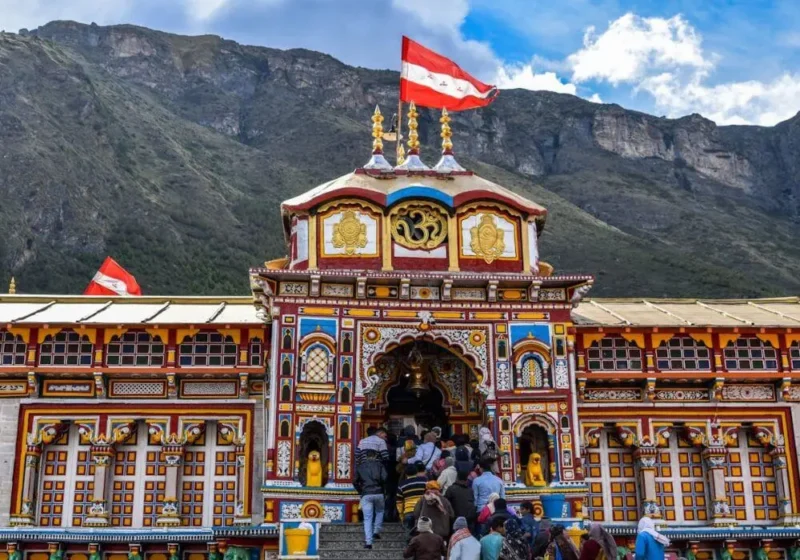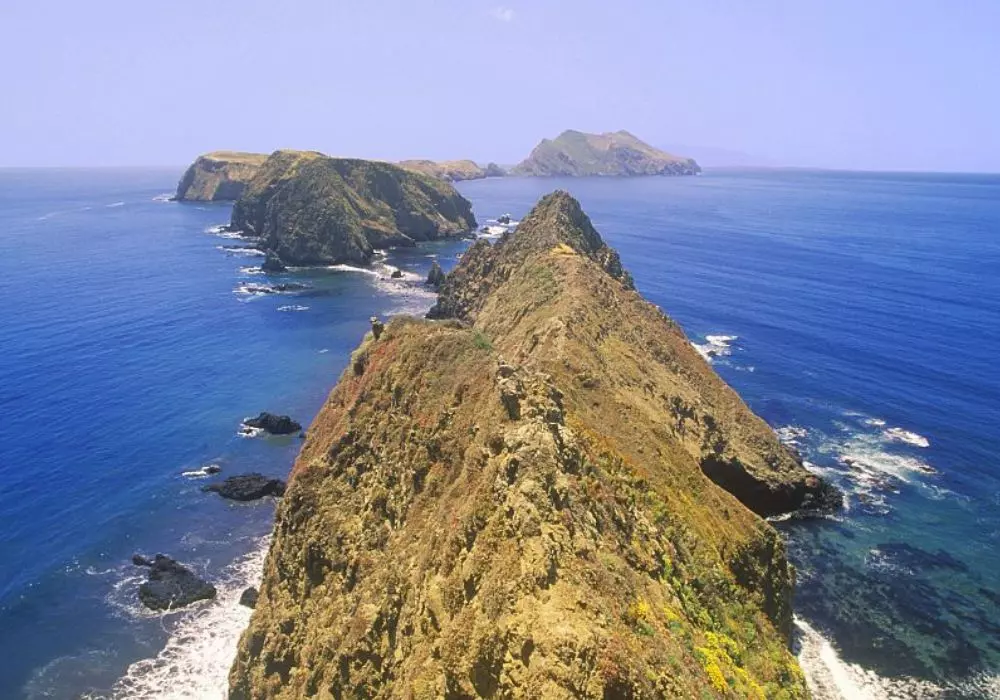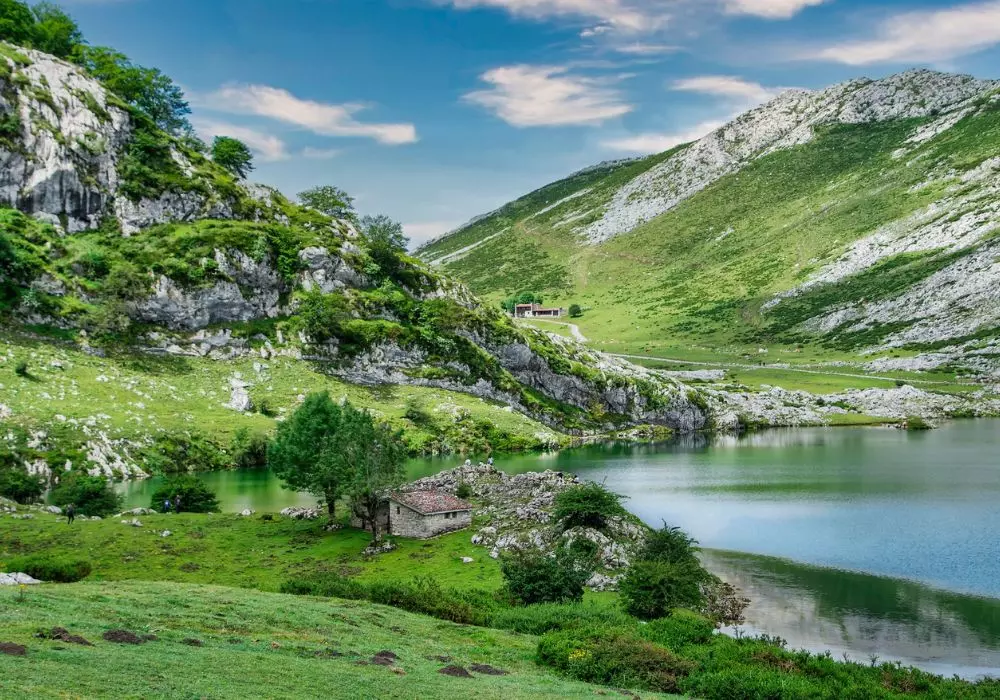The Char Dham Yatra, a revered pilgrimage in Hinduism, holds immense spiritual significance as it encompasses the journey to four holy sites nestled in the Garhwal region of Uttarakhand, India.
The term “Char Dham” refers to the four abodes or seats of deities, namely Yamunotri, Gangotri, Kedarnath, and Badrinath, each representing different facets of the divine.
Embarking on the Char Dham Yatra is not merely a physical journey but a spiritual odyssey, where pilgrims seek blessings and divine intervention for spiritual upliftment and salvation.
The pilgrimage is believed to cleanse the soul of sins and pave the way for moksha, liberation from the cycle of birth and death.
The journey typically begins from Haridwar, known as the “Gateway to the Char Dhams,” where devotees take a holy dip in the Ganges River before proceeding to the higher reaches of the Himalayas.
From Haridwar, pilgrims make their way to Yamunotri, the source of the Yamuna River, where they pay homage to Goddess Yamuna.
The next stop is Gangotri, the origin of the Ganges River, where devotees worship Goddess Ganga. From Gangotri, the journey continues to Kedarnath, home to one of the twelve Jyotirlingas of Lord Shiva, and then concludes at Badrinath, dedicated to Lord Vishnu.
Each of these sites is steeped in mythology and offers a unique spiritual experience. The rugged terrain, pristine surroundings, and the aura of spirituality make the Char Dham Yatra a transformative experience for pilgrims.
The pilgrimage, undertaken by millions of devotees every year, is a testament to the enduring faith and devotion of the people towards the divine.
| Special Tips*: For the Char Dham Yatra, ensure you acclimate to high altitudes and carry altitude sickness remedies. Pack durable, waterproof clothing and maintain hydration with energy-rich snacks to tackle the challenging terrain. |
Char Dham Yatra: Key Details and visit Information
| Feature | Description |
| Location | Uttarakhand, India (also known as Chota Char Dham) |
| Religious Significance | One of the most sacred pilgrimages in Hinduism, believed to cleanse sins and lead to Moksha (liberation) |
| Main Temples | Yamunotri (dedicated to Goddess Yamuna), Gangotri (dedicated to Goddess Ganga), Kedarnath (dedicated to Lord Shiva), and Badrinath (dedicated to Lord Vishnu) |
| Ideal Duration | Typically 10 to 12 days to complete the pilgrimage |
| Season | The Yatra typically takes place from April/May to October/November, depending on weather conditions |
| Accessibility | Accessible by road with trekking required for certain segments; helicopter services are available for some temples |
| Starting Point | Haridwar or Rishikesh, often considered the gateway to the Char Dham Yatra |
| Nearby Attractions | Panch Prayag (the five confluences of rivers in Uttarakhand), Valley of Flowers, Hemkund Sahib, and Mana Village |
| Pilgrimage Experience | Spiritual journey through the Himalayas, including prayers, rituals, and bathing in sacred rivers |
| Climate | Cold and temperate climate; the temples are closed during winter due to heavy snowfall |
| Best Time to Visit | May to June and September to October for optimal weather and to avoid the monsoon season |
Yamunotri
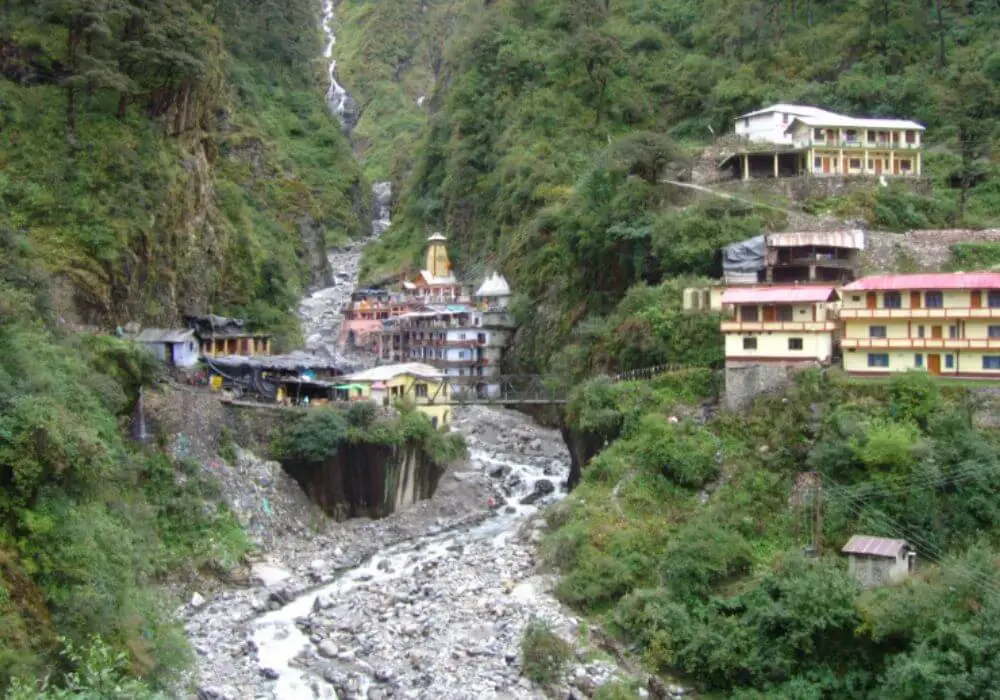

Yamunotri, situated in the Uttarkashi district of Uttarakhand, is one of the Char Dhams and holds immense significance in Hindu mythology. It is the source of the Yamuna River, which is considered sacred in Hinduism.
Location and Access
Yamunotri is located at an altitude of about 3,293 meters in the Garhwal Himalayas. The region is accessible by road from major cities like Dehradun and Rishikesh.
The nearest airport is Jolly Grant Airport in Dehradun, and the nearest railway station is in Rishikesh.
Religious Significance
According to Hindu mythology, Yamunotri is the place where the sage Asit Muni resided and bathed daily in both the Ganges and the Yamuna.
Unable to go to Gangotri during his old age, a stream of the Ganges appeared opposite Yamunotri for him.
The Yamuna River is considered the sister of Yama, the god of death, and bathing in its waters is believed to cleanse one of their sins and protect them from untimely death.
Main Attractions
- Yamunotri Temple: The main attraction is the Yamunotri Temple, dedicated to Goddess Yamuna. The temple was built in the 19th century by Maharani Guleria of Jaipur and underwent renovations later. It is constructed of rough stone and is dedicated to the goddess in the form of a black marble idol.
- Surya Kund and Divya Shila: Surya Kund is a natural thermal spring where pilgrims cook rice and potatoes to offer at the temple. Divya Shila, a rock pillar, is worshipped before entering the Yamunotri Temple.
Travel Tips
- The best time to visit Yamunotri is from May to June and September to October.
- Accommodation options include guesthouses and ashrams in Yamunotri, Janki Chatti, and Hanuman Chatti.
- Due to the high altitude, travelers should take precautions against altitude sickness, such as staying hydrated and acclimatizing gradually.
Gangotri
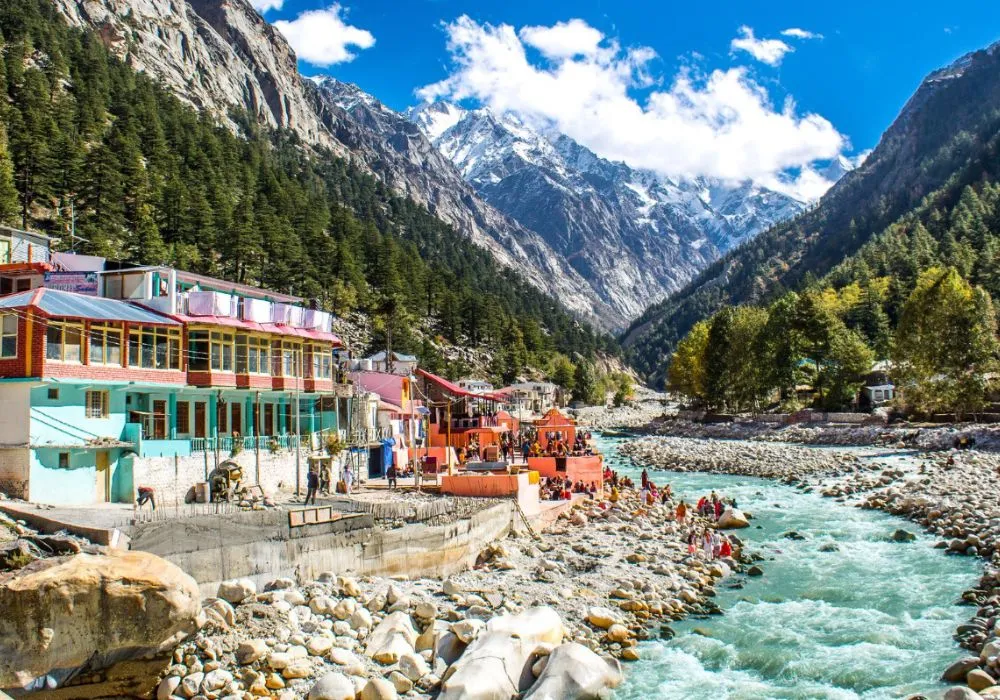

Gangotri is a town and a revered pilgrimage site in the Uttarkashi district of Uttarakhand, India.
It is located at an altitude of about 3,100 meters and is the source of the Ganges River, making it a significant place of worship for Hindus.
Location and Access
Gangotri is situated in the Garhwal Himalayas and is accessible by road from major cities like Dehradun and Rishikesh.
The nearest airport is Jolly Grant Airport in Dehradun, and the nearest railway station is in Rishikesh. From there, one has to travel by road to reach Gangotri.
Religious Significance
According to Hindu mythology, Gangotri is the place where King Bhagirath performed penance to bring the Ganges River to earth to liberate the souls of his ancestors.
It is believed that bathing in the waters of the Ganges at Gangotri cleanses one of their sins and paves the way for salvation.
Main Attractions
- Gangotri Temple: The main attraction in Gangotri is the Gangotri Temple, dedicated to Goddess Ganga. The temple was built in the 18th century by the Gorkha General Amar Singh Thapa. It is made of white granite and is situated near the banks of the Bhagirathi River.
- Bhagirathi Shila: This rock is believed to be the spot where King Bhagirath meditated to please Lord Shiva and bring the Ganges to earth. Pilgrims often offer prayers and perform rituals at this sacred spot.
Travel Tips
- The ideal time to visit Gangotri is from May to June and September to October.
- Accommodation options include guesthouses and dharamshalas in Gangotri town.
- Visitors should be aware of local customs and traditions, such as the practice of removing footwear before entering temples and respecting the environment by not littering.
Kedarnath
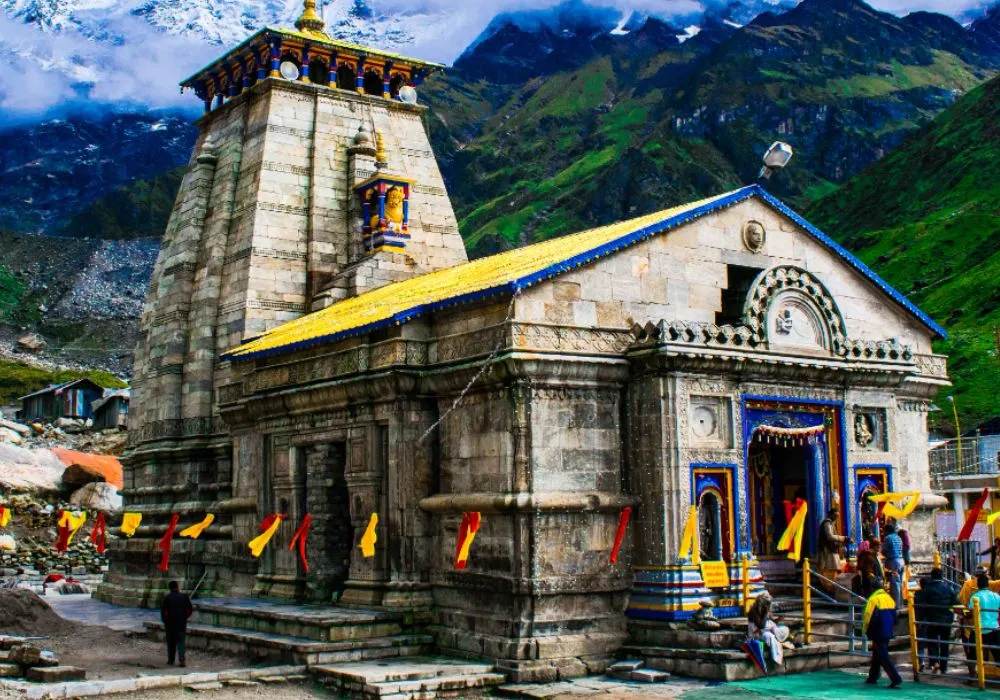

Kedarnath, located in the Rudraprayag district of Uttarakhand, is a town revered for its religious significance.
It is one of the Char Dhams and is also counted among the twelve Jyotirlingas, making it a highly important pilgrimage site for Hindus.
Location and Access
Situated at an altitude of about 3,583 meters in the Garhwal Himalayas, Kedarnath is accessible by road from cities like Dehradun and Rishikesh.
The nearest airport is Jolly Grant Airport in Dehradun, and the nearest railway station is in Rishikesh. From these points, one has to travel by road and then trek to reach Kedarnath.
Religious Significance
According to mythology, Kedarnath is the place where Lord Shiva manifested in the form of a Jyotirlinga.
It is believed that the Pandavas, after the Kurukshetra war, sought the blessings of Lord Shiva to atone for their sins.
The temple is also associated with the story of Adi Shankaracharya, who is said to have attained samadhi at Kedarnath.
Main Attractions
- Kedarnath Temple: The main attraction in Kedarnath is the Kedarnath Temple, dedicated to Lord Shiva. The temple is built of large, heavy, evenly cut gray stones and is considered an architectural marvel. It stands amidst the majestic snow-capped peaks of the Himalayas, creating a breathtaking backdrop.
- Vasuki Tal: A picturesque lake located about 8 km from Kedarnath, Vasuki Tal is surrounded by mountains and offers a tranquil environment for meditation and reflection.
Travel Tips
- The best time to visit Kedarnath is from May to June and September to October.
- Accommodation options in Kedarnath include guesthouses and dharamshalas.
- Trekking is a popular activity in the area, with routes leading to places like Vasuki Tal and the Chorabari Glacier. Visitors should be prepared for high altitudes and changing weather conditions.
Badrinath
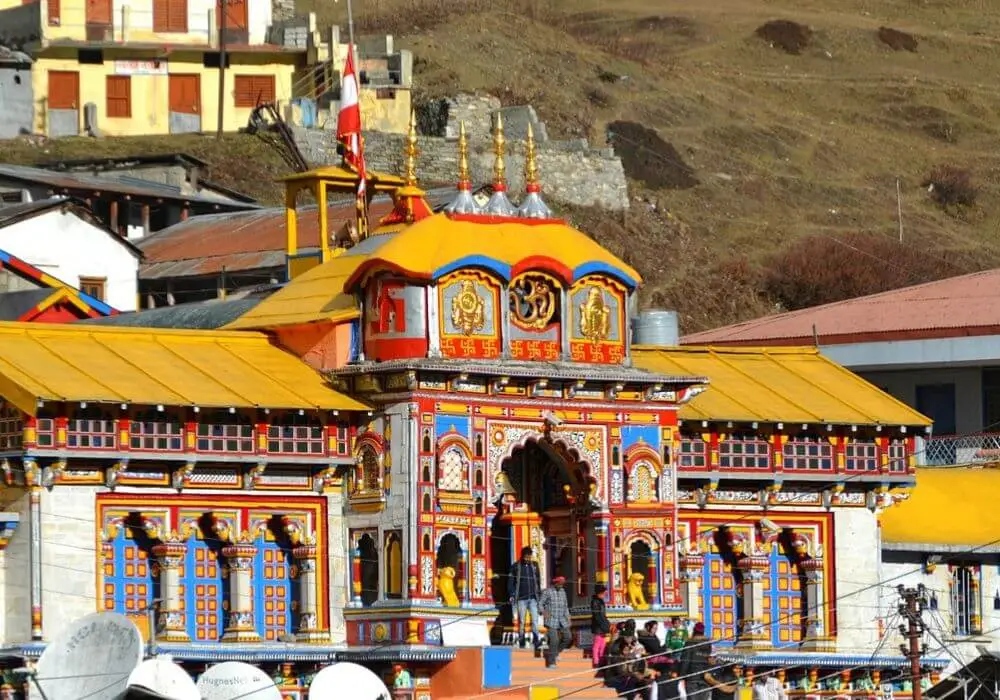

Badrinath, located in the Chamoli district of Uttarakhand, is a sacred town and a major pilgrimage site for Hindus.
It is one of the Char Dhams and is dedicated to Lord Vishnu, specifically in his Badri form.
Location and Access
Situated at an altitude of about 3,133 meters in the Garhwal Himalayas, Badrinath is accessible by road from cities like Dehradun and Rishikesh.
The nearest airport is Jolly Grant Airport in Dehradun, and the nearest railway station is in Rishikesh. From these points, one has to travel by road to reach Badrinath.
Religious Significance
According to mythology, Badrinath is the place where Lord Vishnu meditated for thousands of years in the form of the Badri-Narayan deity.
It is believed that Adi Shankaracharya discovered a black stone image of Lord Badri Narayan in the Alaknanda River and enshrined it in the temple.
Main Attractions
- Badrinath Temple: The main attraction in Badrinath is the Badrinath Temple, dedicated to Lord Vishnu. The temple is believed to have been established by Adi Shankaracharya in the 8th century. It is built in the North Indian temple style and is made of stone and wood with a gold gilt roof.
- Tapt Kund: A natural thermal spring located near the temple, Tapt Kund is believed to have medicinal properties. Pilgrims take a dip in its waters before entering the temple.
- Brahma Kapal: This is a flat platform on the bank of the Alaknanda River where rituals for the dead are performed. It is believed that performing these rituals at Brahma Kapal ensures that the soul attains salvation.
Travel Tips
- The ideal time to visit Badrinath is from May to June and September to October.
- Accommodation options in Badrinath include guesthouses and dharamshalas.
- Local cuisine in Badrinath includes simple vegetarian fare. Shopping options include souvenirs and religious items.
Char Dham Yatra 2024: Opening Dates and Schedule
Char Dham Temple Opening Dates
- Yamunotri Temple: 10th May 2024 at 7:00 AM
- Gangotri Temple: 10th May 2024
- Kedarnath Temple: 10th May 2024 at 7:00 AM
- Badrinath Temple: 12th May 2024 at 6:00 AM
Conclusion
In conclusion, the Char Dham Yatra stands as a testament to the profound spiritual beliefs and cultural heritage of India.
This sacred pilgrimage, encompassing the journey to the four holy sites of Yamunotri, Gangotri, Kedarnath, and Badrinath, holds a special place in the hearts of millions of devotees.
The Char Dham Yatra is not just a physical journey but a spiritual odyssey that offers devotees an opportunity to connect with their faith and seek blessings from the divine.
Each of the Char Dhams holds its own significance and symbolism, representing different aspects of Hindu mythology and spirituality.
The journey to the Char Dhams begins with a dip in the holy waters of the Ganges at Haridwar, the starting point of the pilgrimage.
From there, pilgrims embark on a challenging yet rewarding journey through the majestic Himalayas, seeking the blessings of Yamunaji, Gangaji, Kedarnathji, and Badrinathji.
The rugged terrain, stunning landscapes, and the aura of spirituality make the Char Dham Yatra a truly transformative experience.
Pilgrims often return from the journey with a renewed sense of faith and devotion, having witnessed the divine presence in the natural beauty of the Himalayas.
The Char Dham Yatra is not just a religious pilgrimage but a cultural and spiritual journey that transcends boundaries and unites people from all walks of life.
It is a journey of self-discovery, faith, and devotion, and one that leaves a lasting impression on the hearts and minds of all who undertake it.
